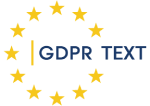Article 33 GDPR. Notification of a personal data breach to the supervisory authority
1. In the case of a personal data breach, the controller shall without undue delay and, where feasible, not later than 72 hours after having become aware of it, notify the personal data breach to the supervisory authority competent in accordance with Article 55, unless the personal data breach is unlikely to result in a risk to the rights and freedoms of natural persons. Where the notification to the supervisory authority is not made within 72 hours, it shall be accompanied by reasons for the delay.
2. The processor shall notify the controller without undue delay after becoming aware of a personal data breach.
(a) describe the nature of the personal data breach including where possible, the categories and approximate number of data subjects concerned and the categories and approximate number of personal data records concerned;
(b) communicate the name and contact details of the data protection officer or other contact point where more information can be obtained;
(d) describe the measures taken or proposed to be taken by the controller to address the personal data breach, including, where appropriate, measures to mitigate its possible adverse effects.
The latest consolidated version of the Regulation with corrections by Corrigendum, OJ L 127, 23.5.2018, p. 2 ((EU) 2016/679). Source: EUR-lex.
(75) The risk to the rights and freedoms of natural persons, of varying likelihood and severity, may result from personal data processing which could lead to physical, material or non-material damage, in particular: where the processing may give rise to discrimination, identity theft or fraud, financial loss, damage to the reputation, loss of confidentiality of personal data protected by professional secrecy, unauthorised reversal of pseudonymisation, or any other significant economic or social disadvantage; where data subjects might be deprived of their rights and freedoms or prevented from exercising control over their personal data; where personal data are processed which reveal racial or ethnic origin, political opinions, religion or philosophical beliefs, trade union membership, and the processing of genetic data, data concerning health or data concerning sex life or criminal convictions and offences or related security measures; where personal aspects are evaluated, in particular analysing or predicting aspects concerning performance at work, economic situation, health, personal preferences or interests, reliability or behaviour, location or movements, in order to create or use personal profiles; where personal data of vulnerable natural persons, in particular of children, are processed; or where processing involves a large amount of personal data and affects a large number of data subjects.
(85) A personal data breach may, if not addressed in an appropriate and timely manner, result in physical, material or non-material damage to natural persons such as loss of control over their personal data or limitation of their rights, discrimination, identity theft or fraud, financial loss, unauthorised reversal of pseudonymisation, damage to reputation, loss of confidentiality of personal data protected by professional secrecy or any other significant economic or social disadvantage to the natural person concerned. Therefore, as soon as the controller becomes aware that a personal data breach has occurred, the controller should notify the personal data breach to the supervisory authority without undue delay and, where feasible, not later than 72 hours after having become aware of it, unless the controller is able to demonstrate, in accordance with the accountability principle, that the personal data breach is unlikely to result in a risk to the rights and freedoms of natural persons. Where such notification cannot be achieved within 72 hours, the reasons for the delay should accompany the notification and information may be provided in phases without undue further delay.
(87) It should be ascertained whether all appropriate technological protection and organisational measures have been implemented to establish immediately whether a personal data breach has taken place and to inform promptly the supervisory authority and the data subject. The fact that the notification was made without undue delay should be established taking into account in particular the nature and gravity of the personal data breach and its consequences and adverse effects for the data subject. Such notification may result in an intervention of the supervisory authority in accordance with its tasks and powers laid down in this Regulation.
(88) In setting detailed rules concerning the format and procedures applicable to the notification of personal data breaches, due consideration should be given to the circumstances of that breach, including whether or not personal data had been protected by appropriate technical protection measures, effectively limiting the likelihood of identity fraud or other forms of misuse. Moreover, such rules and procedures should take into account the legitimate interests of law-enforcement authorities where early disclosure could unnecessarily hamper the investigation of the circumstances of a personal data breach.
Documents
Article 29 Working Party, Opinion 03/2014 on “Personal Data Breach Notification (2014).
Article 29 Working Party, Guidelines on Personal Data Breach Notification Under Regulation 2016/679 (2018).
EDPB, Guidelines 1/2021 on Examples regarding Data Breach Notification (2021).
DPC (Ireland), Guidance for Individuals who Accidentally Receive Personal data (2020).

ISO/IEC 27701, adopted in 2019, added a requirement additional to ISO/IEC 27002, section 16.1.1.
Here is the relevant paragraph to article 33 GDPR:
6.13.1.1 Responsibilities and procedures
Implementation guidance
As part of the overall information security incident management process, the organization should establish responsibilities and procedures for the identification and recording of breaches of PII. Additionally, the organization should establish responsibilities and procedures related to notification to required parties of PII breaches (including the timing of such notifications) and the disclosure to authorities, taking into account the applicable legislation and/or regulation.
[…]
Sign in
to read the full text